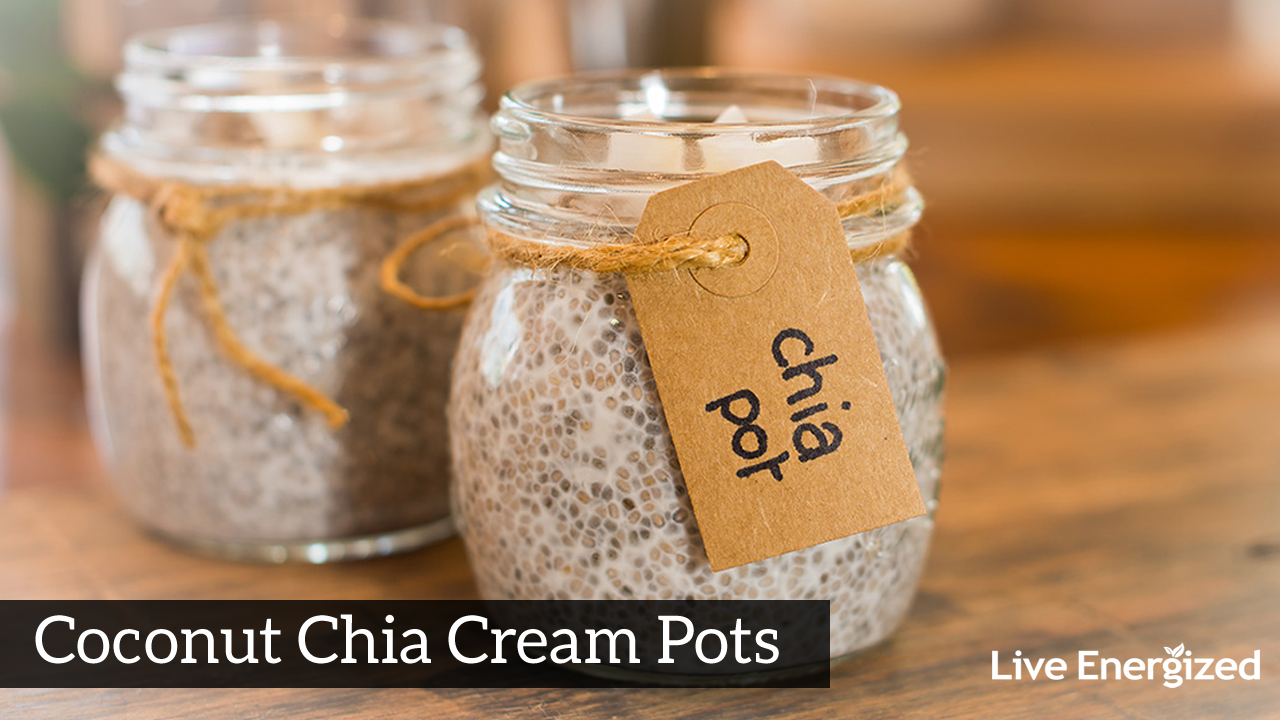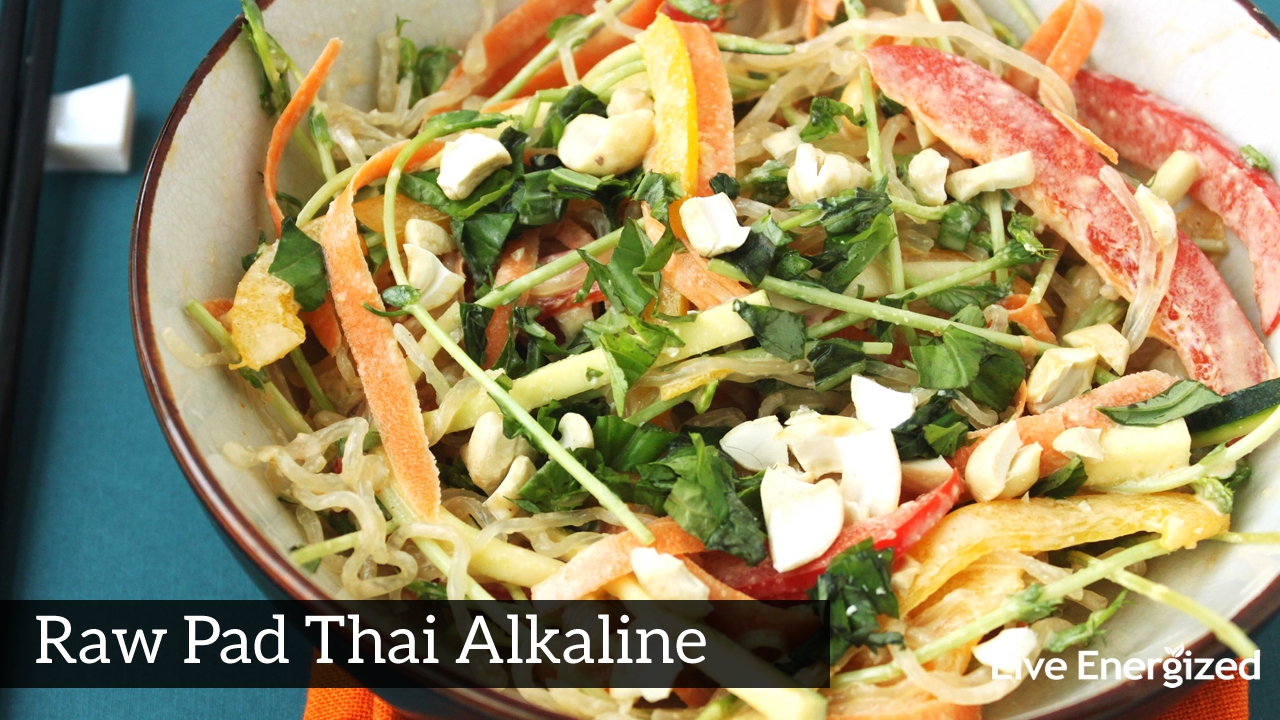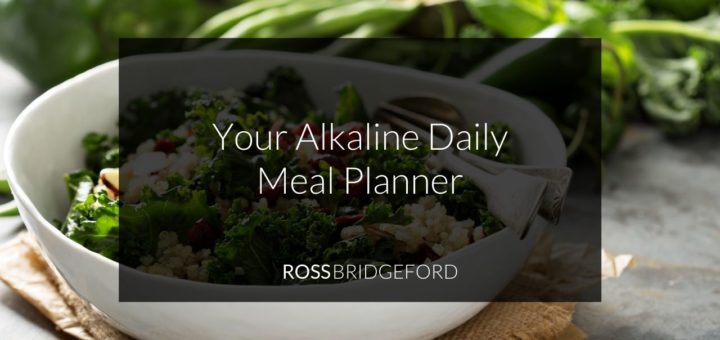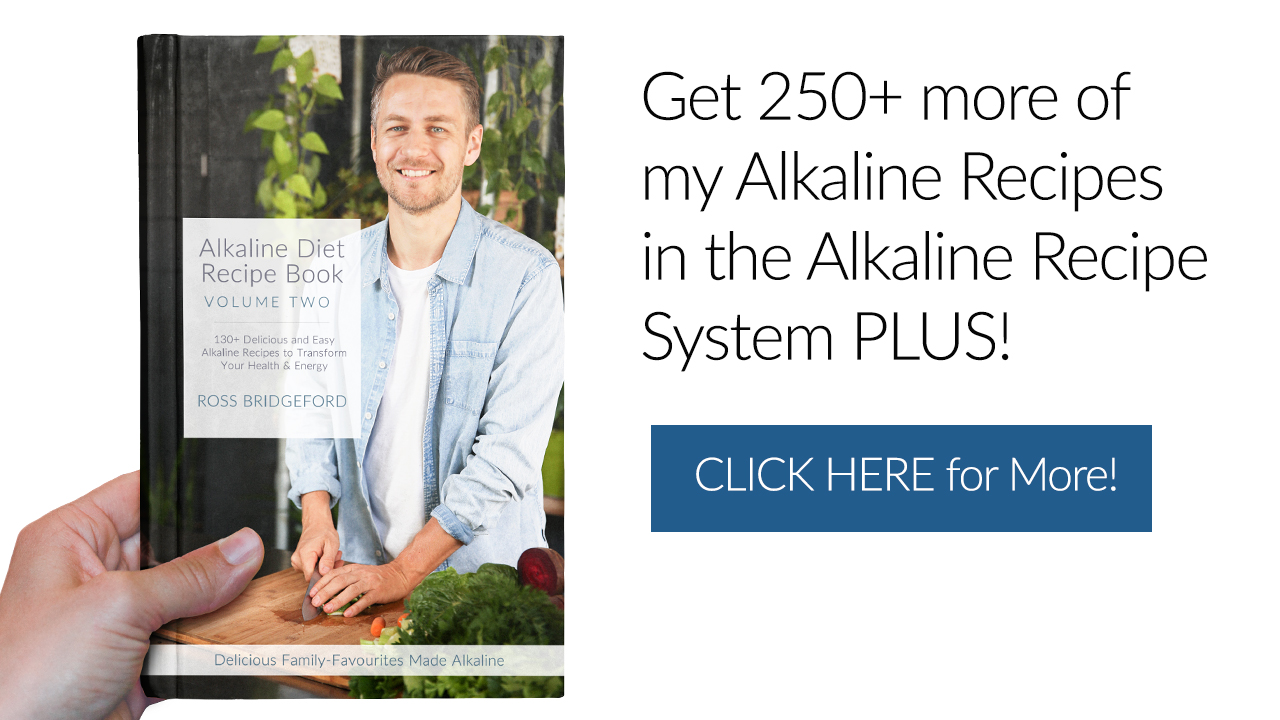Alkaline Daily Food Planner
The Alkaline Food Planner (what’s for dinner?)
You want to get your health to the next level. Maybe that’s moving out of pain, or towards pleasure – getting rid of inflammation, losing weight or regaining your energy.
Whatever your goal, you now know that following the alkaline path is the right choice…
…but what are you going to eat?
This is the #1 question I get from people when they first start out with me.
Especially those who have just downloaded their Alkaline Food Chart…
“Great! I know which foods to eat and avoid…but what do I cook?! What’s for dinner?”
In this guide I want to help make it as easy and effortless as possible for you to implement the alkaline diet, to make it do-able, achievable and fun (and delicious of course).
I will be walking you through each of the meal times to give you an alkaline breakfast, energising lunch and satisfying dinner…and we might even find a little time to cover some alkalizing snacks too!
The Alkaline Food Planner
What to Cook & Eat for Breakfast, Lunch & Dinner
Living alkaline can, and should, be a breeze…
A little guidance from me, a little pre-prep and forethought and it’s so easy – and that’s what today is all about – your Alkaline Food Planner!
Here we go, kicking off with the alkaline breakfast.

Alkaline Food Planner: Let’s Start With Breakfast
Breakfast is the meal people find trickiest at first because most of the traditional breakfast foods, things like toast, cereal, bagels, muffins, eggs and bacon, sausages, jams, dairy and so on are all indeed acid forming.
It’s not to say you can never have any of these ever again, but they are most definitely all acid forming.
The top two foods you want to be eliminating if you want to regain and/or level up your health, energy and vitality are sugar & gluten.
And most of these traditional breakfast foods contain one or both of these in abundance.
Getting processed meats, gluten-containing grains like wheat, sugar (even ‘natural sugars’ – see here for my sugar alternatives guide), toast, jam, dairy, caffeine OUT of your early morning breakfast routine will do wonders for your energy, your health and especially your weight (whether you’re over or UNDER weight).
These types of foods cause all manner of issues, and they’re especially important to avoid early in the day. Just a handful of the problems they cause include:
The Horrible Horrors of Sugar & Gluten
- They exhaust your body’s very small alkaline buffering capacity so soon after waking. Putting the body in a state of chronic acidosis causes massive inflammation and leads to a host of serious challenges and imbalances within the body – stressing the adrenals, the liver, the kidneys, your digestive system and so much more (1)
- It flips your ‘cortisol curve’. Spiking blood sugar so soon after waking causes massive disturbances to what is known as your ‘cortisol curve’ – the levels of cortisol produced in your body that impact practically every other area of your health. In recent studies, an inverted cortisol curve is a greater predictor of premature death than smoking!(2)
- The spiking of blood sugar so soon after waking is also a massive issue, as the elevated blood sugar requires elevated insulin release to mop it all up. The knock-on effect of this is that you will then have a huge blood sugar DIP about 90 minutes later, prompting a craving for more sugar. PLUS the elevated insulin blocks your body’s ability to recognise the leptin floating in your bloodstream, and so your brain will keep sending you the message that you’re still hungry – which contributes to overeating, and of the wrong types of foods(3)
- The blood sugar spike and insulin production also causes an inflammatory response in your body – raising cortisol levels and lowering your pH…making this a vicious cycle(4)
I could go on but I’ll stop there – you need to fix your breakfast.
Some of my FAVOURITE breakfasts in my alkaline food planner (which I expand on in my guide “The Perfect Breakfast Formula” here) include:
Ross’ Favourite Breakfasts:
- Alkaline Oats: simply cooking organic oats in filtered water, adding chia, coconut oil, chopped raw almonds, and then adding a little coconut cream at the end. This is delicious, fatty (good fats – which are hormone balancing, alkaline and metabolism boosting), protein and fibre-rich and super filling.
- Chia Pots: all you need to do is put some chia seeds in a glass, bowl or mug, add coconut milk or almond milk (the carton variety, not coconut milk in a can – that’s too thick), and stir every few minutes or so. Put it in the fridge and wait for the chia to swell. Then top with some blueberries and coconut yoghurt and you’re good to go. So delicious it could be a dessert.
- Gluten-Free Cereal or Muesli: either a store-bought version (check for added sugars etc), or a homemade mix of buckwheat, oats, amaranth, chia, quinoa flakes – whatever takes your fancy – served with almond or coconut or any other nut milk.
- Alkaline Juices & Smoothies: I have gazillions of alkaline juice & smoothie recipes on this site for you to try – but the crash course is for you to just think GREEN with lots of fresh, raw veggies. It is important that you don’t include fruits in your green juices or smoothies, as the fructose in this quantity and this speed of consumption will stress the liver no end.Remember – fructose can only be processed by the liver and is a primary cause of fatty liver – so leave the fruit out. Base your green drink on delicious green foods such as kale, spinach, watercress, beets, celery, cucumber and herbs & spices such as ginger, turmeric, basil, coriander (cilantro), parsley and so on.And base your green smoothies the same but remember to add lots of healthy fats like avocado, almonds, coconut oil, coconut milk/cream, chia and so on.
- Vegetable-Based Breakfasts: I know that might sound weird, but before long, you’ll be craving veggies all of the time. One of my absolute favourites is the simple combination of a bed of warm, fluffy quinoa topped with lightly steamed broccoli, fresh tomato, avocado, and roughly chopped basil and spinach, dressed with olive oil, lemon juice, Himalayan salt and cracked black pepper.
- A Good Ol’ Cooked Breakfast: and you can still have a cooked brekkie – grilled tomatoes, wilted spinach, some sprouted bread toasted, avocado, and I love to make a homemade bean mix of kidney beans, capsicum (bell pepper), tomatoes, finely chopped broccoli and so on in a saucepan. You can get creative – and if you have eggs once a week, that’s not the end of the world.
Foods to Avoid at Breakfast:: gluten-containing grains (wheat, rye, spelt, barley), sugar, dairy, jam, bread, bagels, baked goods, caffeine, animal protein, processed meats, cereals containing gluten, yeast, margarine.
Foods to Eat Instead at Breakfast: gluten-free grains (buckwheat, amaranth), oats, quinoa, chia, healthy fats such as omega 3s and coconut oil, green foods, low-sugar fruits inc. grapefruit, avocado, sprouted breads.
Alkaline Food Planner: Breakfast Recipes to Try

Alkaline Food Planner: Lunch
The challenge with lunch is that 5/7ths of the time most of us are out of the home, at the office, on-the-go and generally a little time-poor. At breakfast, we can make up for a lack of preparation by setting the alarm 10 minutes earlier. But with lunch we don’t get this luxury – so some preparation and planning can be crucial here.
Now – traditionally, lunch relies heavily on the sandwich, and we need to fix that because sandwiches, generally, are made with wheat bread – and wheat bread, brown, wholemeal or otherwise is horrific for your health. My guide on ‘why you should cut wheat‘ explains this in more depth. But for now, just trust me, you want to stop eating wheat as much as possible, if not completely.
Instead of bread & traditional wheat products look to:
- Gluten-Free Bread: not a long-term solution, because these products are still quite processed and refined and often contain not-the-most-alkaline ingredients, but it’s certainly a quick, handy, easy and instant swap that will dramatically increase the health of your lunch
- Gluten-Free Wraps: even better, as they tend to be much less processed (GF wraps don’t need to replicate the sponginess/softness of bread so they’re easier to produce without as many refined ingredients).
- Sprouted Breads & Wraps: and even better are sprouted products. Just look out that the producer hasn’t re-added gluten to the ingredients
- Replacing the bread or wrap with a real food – i.e. lettuce! I often just use a big lettuce leaf as my wrap and it works brilliantly. Check this recipe out for my lettuce wraps.
You also want to be looking to recipes that are a total alternative to simply having sandwiches…
Ross’ Favourite Lunches:
- Salads: these can easily be pre-made, in fact, here are twelve of my favourite Salad-in-a-Jar recipes that are super easy to make and fabulously portable for work. It does need a little pre-prep of course, as you need to make these ahead of time, but the payoff is huge. Each salad gives you the chance to have 2-3 serves of leafy greens, loads of alkalinity, antioxidants, healthy fats and more.
- Soups: these can be pre-made in bulk and frozen, making them a very convenient option. My alkaline raw soups such as this Raw Cleansing Alkaline Soup are great because you can remove from the freezer, take to work and by the time it’s lunch it will be defrosted and ready to eat – no heating required!
- Sushi: store bought is fine but home made is way better. They take no time at all to make, and you can use brown rice, quinoa or a mix, and instead of the Japanese vinegar used to bind the rice, I love to mash through avocado to make the rice/quinoa sticky – healthier, more alkaline AND a great source of fats! You can definitely use the sushi sheets – full of chlorophyll, iron, folate, vitamin K and iodine – OR – if you don’t have these, you can roll it all up in strips of zucchini (courgette) like in my alkaline sushi roll-ups recipe here.
- Last Night’s Dinner! I always make ‘too much’. Leftovers are the BEST fall-back plan, for snacks (with kids, instant snacks are lifesavers), or more importantly, another meal. And for taking lunch to work there is nothing better than having last night’s dinner available for your today’s lunch. Don’t leave this to chance – plan in to make too much! Make it a habit that you always make an extra serve or two.
Foods to Avoid at Lunch: bread, sandwiches, wheat noodles and pastas, store-bought sauces, dressings and condiments, microwave meals, ready meals, oven meals.
Foods to Eat Instead at Lunch: salads, greens, soups, juices, smoothies, gluten-free and sprouted breads and wraps, quinoa and rice instead of pasta and noodles (and cous cous).
Alkaline Food Planner: Lunch Recipes to Try

- Cool Quinoa Summer Salad
- Creamy Zucchini Pasta (great warm or cold)
- Crunchy Kale Salad
Alkaline Food Planner: Dinner
Dinner’s challenge is somewhat different to that of breakfast and lunch, but it comes from the same place – lack of preparation. With dinner the pressure point comes when you’re arriving home from work late, the cupboards are bare and you and the family/kids/husband/wife/housemates are hungry, tired, with no time to spare!
I know this situation only too well, it catches out all of us, and with two young ever-hungry boys, I have to be on high alert for this situation!
As with breakfast and lunch, you have to stay ahead of the game and have the pre-preparation done. But in the case of dinner it’s not the pre-preparation of meals, it’s the pre-shopping to make sure you’re always stocked with the right ingredients to make your ‘staples’.
Staples: The Key to Easy Dinner Success
I strongly advise EVERYONE to have their list of ‘staples’ firmly ingrained in their mind – or written out and stuck to the fridge is your memory isn’t what it used to be 🙂
These ‘staples’ are your four or five meals you enjoy (hopefully love, but ‘enjoy’ is good enough), you know how to cook and you can easily shop for – so always have the ingredients at hand.
So I want you to create your ‘staples list’ asap. A good starting place is looking towards your current ‘family favourites’ and then working out how you can ‘swap out’ the most acidic foods and replace them with more alkaline-forming alternatives.
This process of using your current favourites as a foundation is usually much easier than starting from scratch. Of course, you can use the Alkaline/Acid Food Charts to work out which are the most acidic foods and which alkaline ones you can swap in.
Try to stop relying on pasta, of course, and steer well clear of convenience meals (microwave, oven-bake ready meals).
Generally speaking, at dinner I love to make:
Ross’ Favourite Dinners:
- Zoodle spaghettis & noodle dishes: you can even make your regular pasta sauce (I recommend home-made as store bought pasta-sauces are PACKED with sugar and artificial preservatives etc), and if you have this on top of zucchini (courgette) noodles (often called zoodles) or carrot noodles, or a mix (as I like to) – you have instantly elevated an acid-forming meal into an alkaline-forming one with practically raw vegetable noodles. Awesome switch! I love to do this and make a raw tomato pasta sauce by blending tomatoes, cucumber,
olives, basil, red onion, spinach and to thicken a little steamed pumpkin or butternut squash. Well seasoned and with a glug of good quality olive oil it’s a real winner. You can also check out a heap more zoodle recipes here. - Curries: I have always been a big curry fan – and in my own personal alkaline food planner, my curries are always top of the list. You just need to get out of the habit of store-bought jars of curry sauce and put in the extra 5-10 minutes to make your own. Thai and Indian curries are a great base for you to add a TON of veggies – and served on top of brown rice, red rice or quinoa, it’a a filling and delicious alkaline meal (which is easy to make too much of and have those leftovers waiting for you!/strong>
- Stir-Fry: quickly stir-frying veggies in coconut oil (which does not spoil in heat, unlike other oils so is safe for cooking) is the ultimate ready-meal. Think tons of leafy greens, eggplant (aubergine), zucchini (courgette), carrot and more – served on zoodles, rice or quinoa. You can make an alkaline sauce to go with it, like my cashew sauce here, or just squeeze over lemon juice, some Bragg liquid aminos (or a little tamari), and you’re good to go.
- Steamed Veg with Alkaline Sauces: keeping it really simple, which is essential some nights, it’s great to have a mountain of steamed alkaline veggies topped with a fresh, raw sauce (similar to the pasta sauce I described earlier). This takes under 20 minutes and is an ideal quick dinner when you get home late and tired. And a bonus is, it will energize you instead of having you fall asleep on the sofa 20 minutes later.
- Gigantic Salads: I’m not just talking a regular salad here. A regular salad wouldn’t do it for me at dinner time. I’m talking a massive salad – including all the regular, usual suspects like leaves, tomato, cucumber, avocado etc – but then with added ‘big guns’ like:
- chickpeas, kidney beans, cannelini beans or any other pulses like this
- quinoa
- rice
- tofu
- extra veggies such as pumpkin, asparagus, zucchini (courgette)
Take your salad from a side to a main and make it large! You can get full on salad after all.
These are my kind of staples – and I urge you to find yours too!
Foods to Avoid at Dinner: pasta, store bought sauces (esp. pasta and curry), microwave meals, oven bake meals, takeaways, packaged and fast foods, excessive animal protein, excessive simple carbs like white potato.
Foods to Eat Instead at Dinner: tons of veggies(!), leafy greens, homemade sauces and dressings, quinoa, vegetable noodles (zoodles), salads.
Alkaline Food Planner: Dinner Recipes to Try

Alkaline Food Planner: Supplements
A special mention should go to supplements too because they can play a really important role for the busy, the on-the-go and, well, everyone else too.
I am very keen to mention supplements here because I want to make sure you’re headed in the right path – which is to use them to supplement, not replace.
The key with supplements is their name. Do not see and use supplements as a means to cheating or shortcutting – you can’t have a green drink and then think it’s OK to eat rubbish because you had said green drink. These supplements are here to play a supporting role, not be a replacement for proper diet.
I’ll go into more depth on my own supplement routine and recommendations for you in another guide soon, but for now there are two I want to mention as a back-up to your food planner to make sure no nutritional gaps are missed.
1. Green Drink
These have been a mainstay of my daily routine since 2004 and they changed my life. “Green drinks” are a combination of powdered green grasses (like wheatgrass and barley grass), vegetables (broccoli, kale etc.) and often lots of other superfoods (like ashwagandha, moringa etc.)
Of course, you can get just straight up wheatgrass, but I much prefer a blend, especially if it contains the ‘superfoods’ that you wouldn’t normally get in your diet elsewhere – it does the body a great deal of good to be getting nutrients from a wider variety of sources, because each type of food supplies the nutrients in a different way, filling gaps nutritionally and in essence ‘keeping your body on it’s toes’!
However, you can take this too far, and I believe that having too many ingredients isn’t a great thing either. If your green drink contains 30 or 40 ingredients then it can mean you’re getting such a small amount of each food that you need to have a ton of it to get the core basics such as the wheatgrass, beets or broccoli.
This is why I love Daily Greens from Alkamind – it has a core of around 8-10 main ingredients (plus a few extra kinds of grass etc as a blend).
You also need to make sure they’re organic, GMO-free and high quality.
You really do get what you pay for and I’d rather you spend more per month and get something that will work vs. pay less and get a pot of useless filler ingredients.
Believe me, in my time in the supplement industry we used to regularly test our supplier’s supplements and frequently found what was inside didn’t match the label. Not that they’d be unsafe, but they would contain MUCH higher concentrations of the cheapest ingredient and almost none of the good stuff (for example, mineral supplements that were all sodium and almost zero magnesium, potassium, calcium, etc.).
A good green drink practically counts a a minimum extra serve of green veggies per day per drink.
The nutritional content of these drinks is powerful. The chlorophyll, vitamins, minerals, antioxidants and of course anti-inflammatories .
Please do make this investment in yourself.
Ross’ Pick:
#2 Fats & Oils
Not officially a supplement because it’s a straight up food, really…but this is so important. You cannot skip getting enough of the essential healthy fats every day.
As per the training, you want to be aiming for:
[+] 3 tbsp omega 3 per day
[+] 1 tbsp saturated fats per day (basically coconut oil)
Omega 3 Supplement
While it is possible to get 3tbsp of omega 3 per day from diet (think leafy greens, chia, flax, oily fish, almonds etc) it’s hard. And especially hard to do every day – so I really do recommend a supplement, and I recommend going for quality too.
Poor quality oils are not just useless, they’re toxic.
For coconut oil – really, you can just buy any organic, 100% coconut oil product. There is no need to search for a specific brand.
For MCT oil, it’s more important to go for quality as these oils do go through more of an extraction process.
Questions About the Alkaline Food Planner?
Using this alkaline food planner, I hope you now have a much clearer understanding of the types of foods you’ll be eating and the recipes you’ll be eating at breakfast, lunch, and dinner.
A little preparation and pre-work are so critical, and it’s only a little, but if you can get this right – get your ‘staples’ and get your alkaline foods planned out you’ll be winning from the word go. This will make it all feel like a breeze…
And when the results start rolling in, you’ll realize just how much it is all worth it!
Enjoy, and if you have any questions, please just ask them below in the comments.
Ross
References & Resources: The Alkaline Food Planner
1) Robey IF.; Examining the relationship between diet-induced acidosis and cancer; Nutr Metab (Lond). 2012; 9: 72.
2) Aschbacher K.; Good Stress, Bad Stress, and Oxidative Stress: Insights from Anticipatory Cortisol Reactivity; Psychoneuroendocrinology. 2013 Sep; 38(9): 1698–1708.
3) Kellerer M, Lammers R, Fritsche A, Strack V, Machicao F, Borboni P, Ullrich A, Häring HU.; Insulin inhibits leptin receptor signalling in HEK293 cells at the level of janus kinase-2: a potential mechanism for hyperinsulinaemia-associated leptin resistance. Diabetologia. 2001 Sep;44(9):1125-32.
4) Dandona P. Aljada A. Bandyopadhyay A.; Inflammation: the link between insulin resistance, obesity and diabetes; Trends in Immunology
Volume 25, Issue 1, January 2004, Pages 4-7







Are oats gluten free? Are they safe to eat for people with thyroid?
Thanks,
Soul
Yes, and yes
I found this great information.
Whats a good omega 3 supplement to buy?
Hi Cheryl
Try Alkamind’s Daily Omega 3 (www.getoffyouracid.com)
R
Hi I am a veggie lover but these are some big changes anyway…its exciting to start something new though and I like the way you encourage a slow start!!
I haven’t read everything but I do have two important questions….what about eggs…how do they affect our bodies???…. and fish… if that’s the best meat out there how many servings can you eat weekly…I just remember hearing that too much can cause mercury poisoning or something like that…?
Of course not.
Thank you for this wonderful information.
I would really like to see “recipes” with measurements, et.c.
Thanks again.
Sincerely,
Shirley
I just saw this after my comment.
“You are posting comments too quickly. Slow down. ?
I really dislike the texture of Chia.
Is there anything that would be an adequate substitute?
Just got my Huron and reading through your book and am gearing up for the 7 day????
Appreciate all the charts and recipes ????????
I love this guide
Thank you
I really like oat milk
Can this be substituted for almond or coconut?
Yep definitely.
Hi Ross. Still finishing your book & thumbing thru your charts. Wow, what a change of diet! Breakfast will be the hardest to figure out. I live in the New Orleans/Mississippi Gulf Coast USA. Needless to say, the diet here keeps the heart hospitals full.
I’ll be working up to starting soon….a Spring cleaning!
Thanks, Robert
Hello, I have 2 questions.
1). I love and Agree with everything you are saying about what to eat but I really don’t like the taste of a lot of vegetables mentioned. How do I get myself to eat all those vegetables?
2). When can we eat fruit? I usually put fruit in my smoothies but you say not to? I usually drink one at lunchtime. You may have mentioned when in the fruit so I apologize if I missed it.
Thanks!
Hi Ross
I did your podcast on Sunday night but never received the literature promised.. I’m hoping you can forward to me today. I’m an iridologist in Ontario Canada. I am trying your approach and definitely feeling a difference. How much fruit intake do you take in a day?
Hey Laura
Just emailed you.
Fruit is usually 2-3 pieces a day…some days none, some days a little more. It’s not a hard rule – but more a guide. To help your liver you shouldn’t have more than 2-3 pieces per day on average.
R
I have ordered and received the book My receipt number is 701-400196-5018641. I can not seem to get to the bonus page thank you
Hey
To access the bonuses head here and enter your order/receipt number: https://training.liveenergized.com/arcorder1#section–85480
Thanks so much for ordering – it means a lot to me and is a huge help to my mission. I hope you love the book 🙂
Ross
Ross:
Is gluten free oatmeal alkaline and safe to eat?
I have purchased ur books and awaiting electronic delivery.
Thank u.
David
Hi. Is it ok to eat alkaline durimg pregnancy?
If so what are recipes that will give me all the nutrients my baby needs with out ne starving?
My husband and I are scheduled for the webinar this afternoon. We’re excited to learn about an alkaline lifestyle and how it will help our health. Will this be recorded for future review?
An automobile accident 3 years ago requiring multiple surgeries to repair hip and pelvis have left me with pain and limited mobility. We were runners prior to this and miss our active lifestyle. Im hoping by reducing inflammation in my body I will feel less pain
Hi. Have been busy reading. It’s a lot to take in all at once. Can I ask comments on brown rice malt syrup. Thanks. Marilyn
Great – it’s the best sweetener you can use as is 0% fructose. STILL HAVING SAID THAT – use very sparingly and in moderation – it’s still acid-forming, it’s just better than the other syrups. Stevia is also a ‘good’ choice.
Hi Ross,
I am very interested in your online training, but I cannot make the date and time on 30 May. Is there going to be any other dates later on the year?
Thanks for all the great tips and advice you give.
Hey Sheila
If you register for it, you’ll be sent all info regarding repeats or replays.
R
what can a peson substitute for (people alergic to) spirulina or chorella.
is there an App I can use to help me “meal-plan”? one that I can add the recipes to, then just choose an ingredient and it suggests – etc? have been looking for ages now….
thanks for your help. I follow everything you do and say (y)
Hi Ross, is it okay to add a teaspoon of the Alkamind Daily Greens to my daily home made green smoothie rather than having it as my daily drink? Also, have read some conflicting information on Wheat Grass stating humans gain no benefit because we don’t have multiple stomachs (like cows) so we can’t digest it. With appreciation Cathy
Hahahaha, it would be true if you were trying to EAT the wheatgrass whole! Would love to know where you saw that 🙂 Let me know if you can remember.
You can def add a green powder to your juice or smoothie, but do still have the extra glass of water that the green powder would have gone into – I wouldn’t like for this tip to end up lowering your hydration!
You mention sprouted bread. The only sprouted bread I can find is Ezekiel and that is not gluten free. What GF sprouted bread do you eat?
There are tons of different brands out there – check Whole Foods or a health food store, but indeed as youve found, some brands put gluten back IN! Crazy. You have to be careful!
I’m really looking forward to watching your live workshop. I basically already eat all the foods and smoothie/juice ingredients you mentioned, eating this way has literally saved my life. I am really interested to learn short cuts in order save time on preparation etc and looking forward to learning more recipes Thankyou for sharing
Karla ????